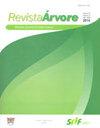PRODUCTION AND FINANCIAL FEASIBILITY IN SILVOPASTORAL SYSTEM IN SMALL RURAL PROPERTY
IF 0.8
4区 农林科学
Q4 FORESTRY
引用次数: 1
Abstract
ABSTRACT The implementation of silvopastoral systems (SPS) on properties that have family farming is an alternative to diversify land use, to acquire more than one production good, and diversify income generation. Therefore, the objective of this study was to evaluate the financial viability and quantify the volume of the forest component in an SPS with a spacing of 3.0 m x 20.0 m for multiple uses, carried out at 4 years of age for a 16-year rotation. For the analysis of financial viability, we used project analysis criteria such as: net present value (NPV), internal rate of return (IRR), and benefit-cost ratio (BCR) for a 16-year horizon with rate benchmarks interest rate of 3%, 4.5% and 10%. Based on the financial analysis criteria, the tree component of the system is viable, as it presented an NPV greater than zero, IRR exceeding the minimum attractiveness rate and BCR greater than 1 for all rates analyzed. The estimated production of the forest component was 257.28 m3/ha in 16 years. Thus, it can be concluded that the forest component in the arrangement of 3.0 m x 20.0 m at 16 years of age, provides a financial return for the small rural property. Therefore, it is a system that brings several economic and environmental advantages, optimizing the use of land, diversifying the production of the small property, generating income, bringing benefits to the reduction of methane gas (CH4) emissions, and assists in carbon sequestration (CO2).小农农牧制度的生产与财务可行性
在拥有家庭农业的土地上实施森林牧养系统(SPS)是使土地利用多样化、获得多种生产产品和使收入多样化的另一种选择。因此,本研究的目的是评价一个人工林的经济可行性,并量化一个人工林的森林组成部分的体积,该人工林的间距为3.0米× 20.0米,用于多种用途,在4岁时进行,轮作16年。为了分析财务可行性,我们使用了项目分析标准,如:净现值(NPV),内部收益率(IRR)和效益成本比(BCR),基准利率为3%,4.5%和10%,为期16年。根据财务分析标准,该系统的树组件是可行的,因为其NPV大于零,IRR超过最小吸引力率,并且所分析的所有利率的BCR大于1。16年森林部分的估计产量为257.28立方米/公顷。因此,可以得出结论,在16岁时,3.0 m x 20.0 m的森林组成部分为小型农村财产提供了经济回报。因此,它是一个具有多项经济和环境优势的系统,可以优化土地利用,使小物业的生产多样化,产生收入,减少甲烷气体(CH4)排放,并有助于碳封存(CO2)。
本文章由计算机程序翻译,如有差异,请以英文原文为准。
求助全文
约1分钟内获得全文
求助全文
来源期刊

Revista Arvore
FORESTRY-
CiteScore
1.00
自引率
0.00%
发文量
32
审稿时长
4-8 weeks
期刊介绍:
A Revista Árvore é um veículo de comunicação científica da Sociedade de Investigações Florestais – SIF. O jornal é de acesso gratuito, revisado por pares, que publica bimestralmente trabalhos científicos originais no campo da Ciência Florestal. As áreas temáticas para publicação são: Ambiência e Conservação da Natureza, Manejo Florestal, Silvicultura e Tecnologia da Madeira e Utilização de Produtos Florestais.
A política editorial visa manter alta conduta ética em relação à publicação e aos seus funcionários, rigor na qualidade dos artigos científicos, seleção de revisores qualificados, respeito profissional aos autores e processo de tomada de decisão imparcial. A Revista Árvore publica artigos apenas em inglês.
Artigos de revisão podem ser publicados se houver uma discussão relevante resumindo o estado da arte sobre o assunto. A revisão estrita da literatura não é aceita.
 求助内容:
求助内容: 应助结果提醒方式:
应助结果提醒方式:


